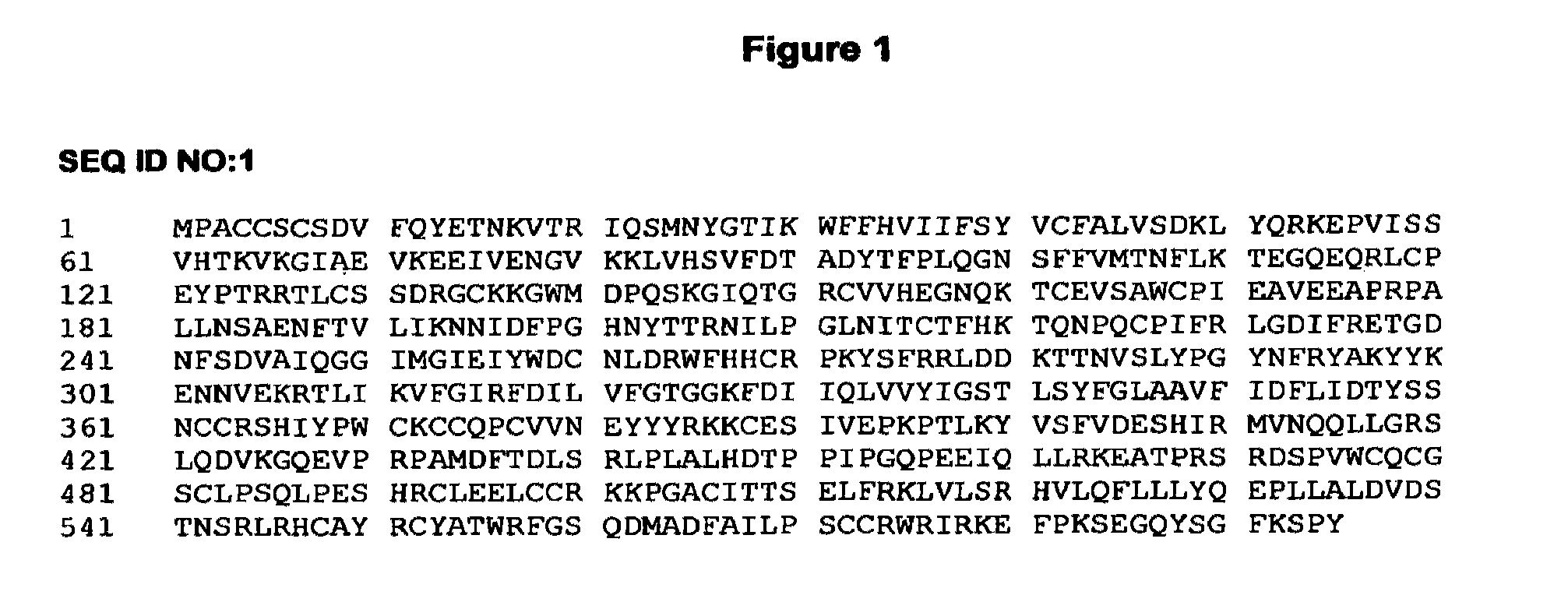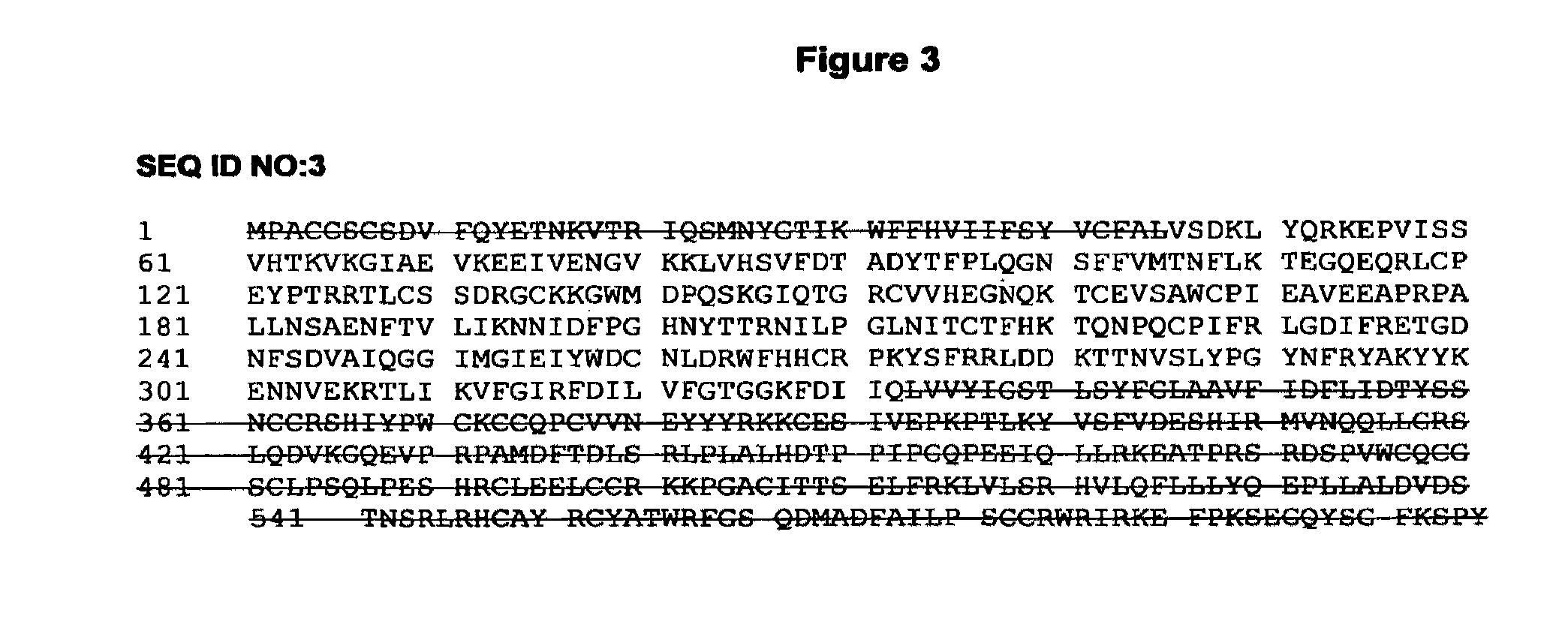Antigen binding sites to non-functional oligomeric P2X7 receptors and methods of use thereof
a technology of p2x7 receptor and antigen binding site, which is applied in the field of antigen binding site to non-functional oligomeric p2x7 receptor and methods of use thereof, can solve the problem of difficult to obtain serological reagents that bind to non-functional p2xsub>7, and achieve the effect of increasing the affinity for p2x7 receptor
- Summary
- Abstract
- Description
- Claims
- Application Information
AI Technical Summary
Benefits of technology
Problems solved by technology
Method used
Image
Examples
example 1
Generation and Purification of 2F6 Antibody
[0287]Objective: The experiments described here detail the generation and purification of an antibody that binds to the P2X7 receptor expressed on live cells. In particular, the experiments describe the generation and purification of an antibody with the sequence as shown in SEQ ID NO: 4 (2F6).
[0288]Background:
[0289]Antigen binding sites that bind a P2X7 receptor monomer are known, however, to date no antibodies are known that bind specifically to conformational epitopes on P2X7 receptors expressed on live cells in a trimer form, specifically spanning the interface between adjacent monomers. The ATP binding sites form at the correctly packed interface between monomers with residues 200-210 on one monomer and residues 296-306 on the adjacent monomer exposed when the receptors are unable to bind ATP as occurs in cancer cells.
[0290]Materials and Methods:
[0291]Generation of E200 and E300 peptide. The complex peptide epitope E200-300 formed part...
example 2
Biochemical Characterisation of 2F6 Antibody Forms
[0312]Objective:
[0313]To determine whether the 2F6 antibody forms, including the IgM and mouse IgG2a, bind to non-functional receptors on the surface of live cells. Also, to determine whether the 2F6 antibody forms inhibit a property of a cell, for example a cancer cell, that expresses non-functional P2X7 receptors.
[0314]Background:
[0315]It is known that cancer cells express non-functional receptors that consist of a trimer of P2X7 receptor monomers. When able to function, the assembled P2X7 receptors on the cell surface bind ATP with the effect that the channel formed between the monomers assembled into a trimer undergoes a transition to a wider pore able to greatly increase the ingress of calcium ions into the cell to initiate caspase activity leading to apoptosis and cell death. Apoptosis is withheld or inhibited in cancer cells that are unable to die even though the P2X7 receptor is deployed on the cell surface. These receptors a...
example 3
Binding of Antibody to Live Tumour Tissue
[0323]Objective:
[0324]To establish whether antibodies directed at a unique accessible composite epitope spanning adjacent monomers within the P2X7 trimer expressed on cancer cell surfaces are more capable of differentially binding to the target on the surface of live cancer cells compared with residual target on dead cancer cells.
[0325]Background:
[0326]The 2F6 antibody binds across adjacent monomers in expressed P2X7 receptors on cancer cells but not on receptors that are expressed on normal cells expressing functional or function-capable P2X7 receptors such as those on white and red blood cells. An antibody able to specifically bind non-functional P2X7 receptors by targeting an epitope confined to a monomer of the receptor is also able to bind to such monomeric targets that may be released from the cytoplasmic compartment of dead cells, thereby reducing therapeutic potential as it becomes partially bound by P2X7 receptors from dead cells in ...
PUM
| Property | Measurement | Unit |
|---|---|---|
| concentrations | aaaaa | aaaaa |
| dissociation constant | aaaaa | aaaaa |
| dissociation constant | aaaaa | aaaaa |
Abstract
Description
Claims
Application Information
 Login to View More
Login to View More - R&D
- Intellectual Property
- Life Sciences
- Materials
- Tech Scout
- Unparalleled Data Quality
- Higher Quality Content
- 60% Fewer Hallucinations
Browse by: Latest US Patents, China's latest patents, Technical Efficacy Thesaurus, Application Domain, Technology Topic, Popular Technical Reports.
© 2025 PatSnap. All rights reserved.Legal|Privacy policy|Modern Slavery Act Transparency Statement|Sitemap|About US| Contact US: help@patsnap.com



